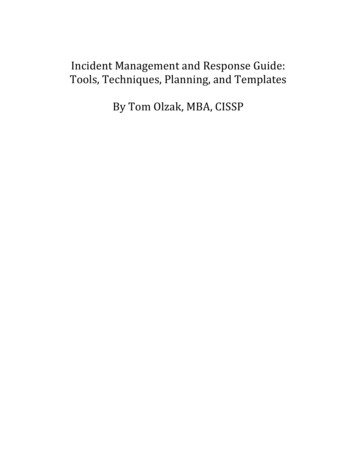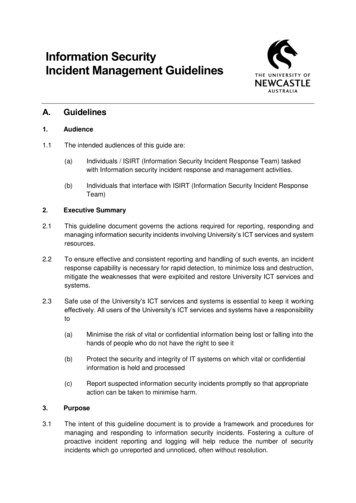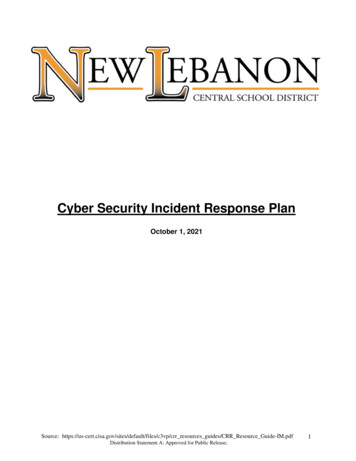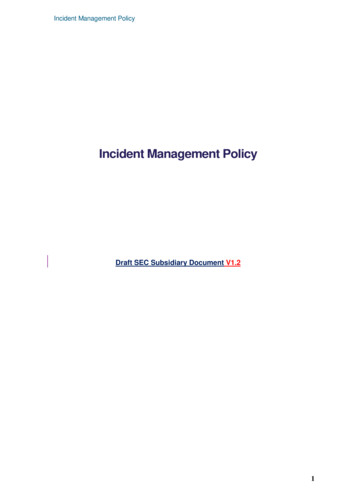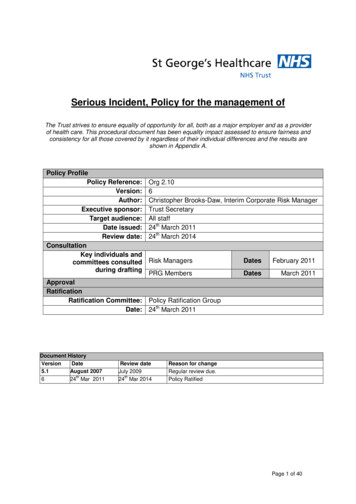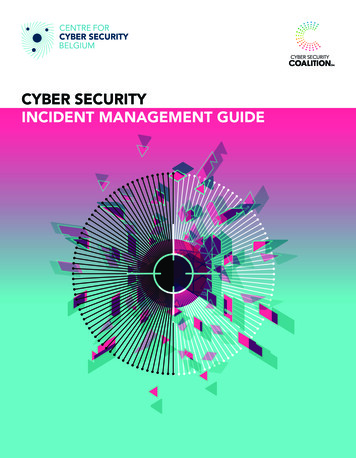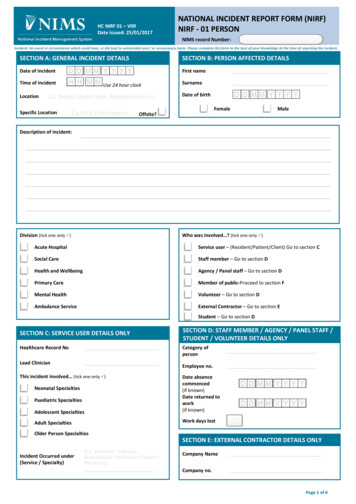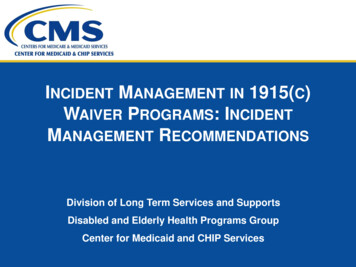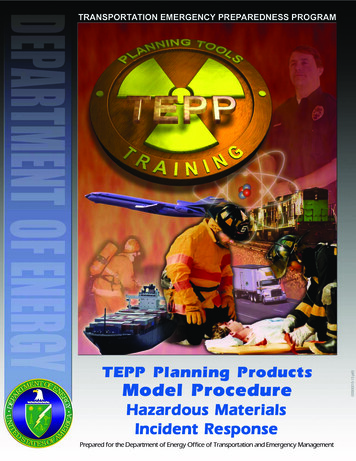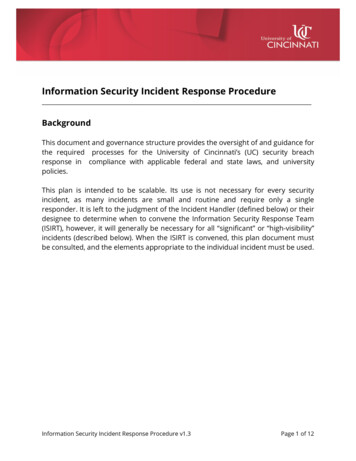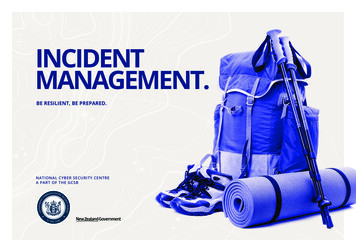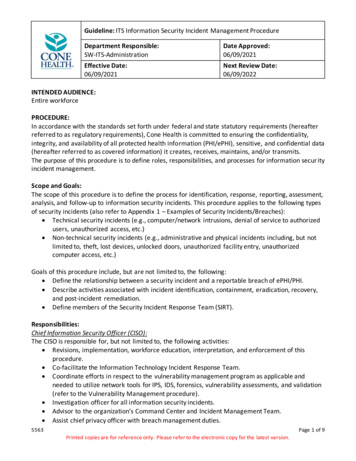
Transcription
Guideline: ITS Information Security Incident Management ProcedureDepartment Responsible:SW-ITS-AdministrationDate Approved:06/09/2021Effective Date:06/09/2021Next Review Date:06/09/2022INTENDED AUDIENCE:Entire workforcePROCEDURE:In accordance with the standards set forth under federal and state statutory requirements (hereafterreferred to as regulatory requirements), Cone Health is committed to ensuring the confidentiality,integrity, and availability of all protected health information (PHI/ePHI), sensitive, and confidential data(hereafter referred to as covered information) it creates, receives, maintains, and/or transmits.The purpose of this procedure is to define roles, responsibilities, and processes for information secur ityincident management.Scope and Goals:The scope of this procedure is to define the process for identification, response, reporting, assessment,analysis, and follow-up to information security incidents. This procedure applies to the following typesof security incidents (also refer to Appendix 1 – Examples of Security Incidents/Breaches): Technical security incidents (e.g., computer/network intrusions, denial of service to authorizedusers, unauthorized access, etc.) Non-technical security incidents (e.g., administrative and physical incidents including, but notlimited to, theft, lost devices, unlocked doors, unauthorized facility entry, unauthorizedcomputer access, etc.)Goals of this procedure include, but are not limited to, the following: Define the relationship between a security incident and a reportable breach of ePHI/PHI. Describe activities associated with incident identification, containment, eradication, recovery,and post-incident remediation. Define members of the Security Incident Response Team (SIRT).Responsibilities:Chief Information Security Officer (CISO):The CISO is responsible for, but not limited to, the following activities: Revisions, implementation, workforce education, interpretation, and enforcement of thisprocedure. Co-facilitate the Information Technology Incident Response Team. Coordinate efforts in respect to the vulnerability management program as applicable andneeded to utilize network tools for IPS, IDS, forensics, vulnerability assessments, and validation(refer to the Vulnerability Management procedure). Investigation officer for all information security incidents. Advisor to the organization’s Command Center and Incident Management Team. Assist chief privacy officer with breach management duties.5563Page 1 of 9Printed copies are for reference only. Please refer to the electronic copy for the latest version.
Guideline: ITS Information Security Incident Management Procedure Facilitate semiannual tabletop exercises with all members of the SIRT to ensure everyoneunderstands their roles.Provide individuals with a process and method to report security issues and/or breachesanonymously.Maintain a list of third-party security contact information in the event an incident needs to bereported to an outside party.Ensure members of the Information Technology Incident Response Team and other workforcemembers that have significant responsibilities related to incident response are properly trainedwithin 90 days of their hire date, or assuming an incident response role, and whenever there issignificant change to the organization’s environment, and within every three hundred sixty-five(365) days thereafter.Ensure members of the Information Technology Incident Response Team are properly trainedto handle incidents that involve or are caused by insider threat.Ensure a duress alarm will be implemented in situations where they are warranted.Chief Privacy Officer:The chief privacy officer is responsible for, but not limited to, the following activities: Co-facilitate the Incident Response Team. Advisor to the organization’s Command Center and Incident Management Team. Alternate investigation officer for all information security incidents. Breach management.Security Incident Response Team (SIRT):The SIRT is responsible for, but not limited to, the following activities: Keep the Command Center and Incident Management Team informed on all incidentmanagement activities. Ensure that all incidents are fully documented from discovery to remediation and include allindividuals involved and the actions that were taken. Provide oversight and management of incident response and reporting activities. Review and approve the breach risk analysis. Specific duties outlined by the Command Center and Incident Management Team member rolesand responsibilities in the Appendix 2. Ensure that incidents are promptly reported to external entities when necessary.Command Center and Incident Management Team:The Command Center and Incident Management Team is responsible for the process by which theorganization deals with major events that threaten to harm the organization, itsstakeholders/customers/clients, or the general public. The Command Center and IncidentManagement Team is responsible for keeping Cone Health’s leadership team appraised onincident/breach management activities.Information and Technology Services (ITS):ITS is responsible for, but not limited to, the following activities:5563Page 2 of 9Printed copies are for reference only. Please refer to the electronic copy for the latest version.
Guideline: ITS Information Security Incident Management Procedure ITS will be responsible for performing activities associated with the containment,eradication, and recovery phases of this procedure.Maintain detailed internal procedures for performing containment, eradication, andrecovery activities.Incident Discovery/Notification:Incident discovery/notification can come from, but not be limited to, the following: Workforce member Insider threat Anonymous call/email Firewall, intrusion detection/prevention, antivirus technology, etc. System audit log review Patient/client/customer Third party vendor/contractor/consultant Internal/external audit Business partner Third party security services (not associated with the organization) Third party threat notification services Media Duress alarmIncident Response Process:The incident response process begins immediately upon discovery or notification. The date/time is veryimportant to the breach notification process if the incident is determined to be a breach of ePHI/PHI(see Breach Notification procedure).The following phases represent the entire information security incident management process. Thesephases often happen quickly and do not necessary happen in the order listed in this procedure. It isalso common for activities within each phase to occur simultaneously.Identification Phase:1. The CISO or chief privacy officer will determine if what is being reported is an event, precursor,or security incident.2. If the issue is an event, the CISO/chief privacy officer will contact the appropriate internalresource for resolution.3. If the issue is a precursor or security incident, the CISO/chief privacy officer will determine if itis technical or non-technical and at the same time activate the SIRT and Command Center andIncident Management Team, and begin to document background information related to theincident on an Information Security Incident Response/Investigation Form. Among other factorsbeing noted in this form, special attention should be given to listing any and all employeesinvolved with the security incident. The SIRT will proceed as follows: Non-Technical Security Incident: The SIRT completes the investigation, implementspreventative measures, and resolves the security incident. Upon completion of theinvestigation, the SIRT will move to the Post-Incident Remediation Phase.5563Page 3 of 9Printed copies are for reference only. Please refer to the electronic copy for the latest version.
Guideline: ITS Information Security Incident Management Procedure Technical Security Incident: Go immediately to the Containment Phase.4. Other activities could include the following: Contact law enforcement (if appropriate). Contact media outlets: If a security incident has already garnered media attention theCommand Center and Incident Management Team may choose to initiate contact withmedia outlets. Cone Health’s media relations representative will serve as the sole pointof contact for activities related to the news media. Begin the breach risk analysis process if it is determined or suspected that ePHI/PHI maybe involved. Contract with a digital forensic analysis firm. Contact cyber-insurance representative.Containment Phase:During this phase, Cone Health’s Information and Technology Services (ITS) department will attempt tocontain the security incident. Depending on the type of incident, actions performed by ITS will vary.It is extremely important to take detailed notes and protect the chain of custody when informationtechnology assets are involved in the incident. This information will be very helpful to digital forensicanalysis and can be used during civil and criminal litigation and/or disciplinary/termination action.Eradication Phase:This phase represents ITS’s activities to remove the cause and patch/repair security vulnerabilities thatresulted in the security incident.Recovery Phase:The Recovery Phase represents ITS’s effort to restore the affected environment back to normaloperation after security vulnerabilities have been remediated.Post-Incident Remediation:The post-incident remediation phase represents the review of the security incident by the SIRT todetermine the following: What additional actions (if any) need to be taken. If breach notification is required (see Breach Notification procedure). Review incident and if applicable, breach related documentation to ensure that it is complete. Whether there are any recurring or high-impact incidents and any improvements to the existingincident response process that need to be implemented.o Prepare formal communication or arrange a meeting with senior leadership to briefthem on the outcome of the incident.o Close the security incident.Incident Response Training and Evaluation:The SIRT will semiannually review and evaluate the processes outlined in this procedure. This activitywill coincide with mandatory exercises to practice the effectiveness and maintain familiarity with theprocess by SIRT members. The business continuity, hospital incident command center, and disasterrecovery teams (responsible for contingency planning activities for the organization) will also be part ofthese exercises. All lessons learned will be incorporated into an updated incident response plan.5563Page 4 of 9Printed copies are for reference only. Please refer to the electronic copy for the latest version.
Guideline: ITS Information Security Incident Management ProcedureDocumentation Retention:Records related to security incidents, risk analysis, and breach decisions will be retained for a period ofno less than 6 years from the date of the documentation.Exception Management:Exceptions to this procedure will be evaluated in accordance with Cone Health’s Information SecurityException Management procedure.Applicability:All employees, volunteers, trainees, consultants, contractors, and other persons (i.e., workforce)whose conduct, in the performance of work for Cone Health, is under the direct control of ConeHealth, whether or not they are compensated by Cone Health.Compliance:Workforce members are required to comply with all information security policies/procedures as acondition of employment/contract with Cone Health. Workforce members who fail to abide byrequirements outlined in information security policies/procedures are subject to disciplinary action upto and including termination of employment/contract.5563Page 5 of 9Printed copies are for reference only. Please refer to the electronic copy for the latest version.
Guideline: ITS Information Security Incident Management ProcedureAppendix 1 – Examples of Security mentDisposal DriveDisposal MobileDisposal TapeEmailFaxFraud SEHackLost ComputerLost DocumentLost DriveLost LaptopLost MediaLost MobileLost TapeMissingDocumentMissing DriveMissing LaptopMissing MediaOtherPhishingSeizureDescriptionDiscovery of computers not disposed of properlyDiscovery of documents not disposed of properlyDiscovery of disk drives not disposed of properlyDiscovery of mobile devices not disposed of properlyDiscovery of backup tapes not disposed of properlyEmail communication exposed to unintended third partyFax communication exposed to unintended third partyFraud or scam (usually insider-related), social engineeringComputer-based intrusionLost computer (unspecified type in media reports)Discovery of documents not disposed of properly, not stolenLost data drive (unspecified if IDE, SCSI, thumb drive, etc.)Lost laptop (generally specified as a laptop in media reports)Media (e.g., disks) reported to have been lost by a third partyLost mobile phone or device such as tablets, etc.Lost backup tapesMissing document, unknown or disputed whether lost or stolenMissing drive, unknown or disputed whether lost or stolenMissing laptop, unknown or disputed whether lost or stolenMissing media, unknown or disputed whether lost or stolenMiscellaneous breach type arising primarily from data mishandlingMasquerading as a trusted entity in an electronic communication toobtain dataForcible taking of property by a government law enforcement official5563Page 6 of 9Printed copies are for reference only. Please refer to the electronic copy for the latest version.
Guideline: ITS Information Security Incident Management ProcedureSkimmingSnail MailSnoopingStolen ComputerStolenDocumentStolen DriveStolen LaptopStolen MediaStolen MobileStolen TapeSystem FailureUnknownVirus (Malware)WebWireless AccessPointUsing electronic devices (such as a skimmer) to swipe victims’ credit/debitcard numbersPersonal information in “snail mail” exposed to unintended third partyExceeding intended privileges and accessing data for unauthorizedpurposesStolen desktop (or unspecified computer type in media reports)Documents either reported or known to have been stolen by a third partyStolen data drive, unspecified if IDE, SCSI, thumb drive, etc.Stolen laptop (generally specified as a laptop in media reports)Media generally reported or known to have been stolen by a third partyStolen mobile phone or device such as tablets, etc.Stolen backup tapesSystem failure or loss of serviceUnknown or unreported breach typeExposure to personal information via virus or Trojan (possibly classified ashack)Web-based intrusion, data exposed to the public via search engines,public pagesInstallation / use of an unauthorized wireless access point5563Page 7 of 9Printed copies are for reference only. Please refer to the electronic copy for the latest version.
Guideline: ITS Information Security Incident Management ProcedureAppendix 2 – Command Center and Incident Management Team Members and PrimaryResponsibilitiesCommand Center andIncident ManagementRolePrimary ResponsibilitiesTeam MemberIncident Commander for Team Leader for Convenes team and chairs Commandthe Health SystemCommand Center andCenter and Incident Management TeamIncident ManagementmeetingsTeam Manages an incident from responsethrough recovery Delegates recovery planning efforts asapplicableChief InformationTeam Leader for SIRT and Convenes team and chairs SIRT meetingsSecurity Officer (CISO)Security advisor Oversees the information securityincident response process. Assists the chief privacy officer withbreach risk analysis activities. Submits progress and final reports tosenior leadership. Submits final report and overseesdebriefing. Tracks and reports on security relatedchanges that could impact businessoperations, resulting from incident.Chief Privacy OfficerAlternate Team Leader Provides information on privacy-relatedfor SIRT and Privacyregulatory requirements.advisor Oversees discovery and investigationfrom a privacy perspective. Recommends steps for privacycompliance and to mitigate the risk ofpenalties. Oversees breach management programand is responsible for breach riskanalysis and notification processes. Advises team on privacy issues.LegalLegal advisor Provides information on major contractsand other obligations that may berelevant to incident and breachmanagement. Oversees discovery and investigationfrom an evidentiary perspective, in thecase of civil or criminal litigation. Provides advice on minimizing legalliability.5563Page 8 of 9Printed copies are for reference only. Please refer to the electronic copy for the latest version.
Guideline: ITS Information Security Incident Management ProcedureCommand Center andIncident ManagementTeam MemberRolePrimary Responsibilities Information Technology(CIO)ITS advisor Finance (CFO)Financial advisor Facilities/PhysicalSecurityFacilities and physicalsecurity advisor Media RelationsPublic relations advisor Emergency ManagementDirectorPeople and CultureEmergency ManagementadvisorPeople and Cultureadvisor Coordinates with internal and externallegal teams as needed.Assists in determining the existence,cause, and extent of an ITS-relatedincident (e.g., reviews firewall/IPS/syslogs for correlating evidence ofunauthorized access).Coordinates incident managementactivities assigned to ITS.Coordinates with ITS to identify victimsin Cone Health systems.Coordinates with ITS organization toplan and implement actions to preventsimilar future incidents.Assists with evaluating financial liability.Provides financial assistance whenneeded.Assists with cost/benefit analysis whenapplying controls.Advises on matters related to physical,facility and environmental security.Coordinates activities between theorganization and law enforcement.Remediates any physical facility changes.Coordinates activities between theorganization and public media.Prepares and issues press releases orstatements, as needed.Acts as liaison to outside agencies andCommand Center operations.Aligns with HICS model for best practice.Advises on employment law issues.If employee personal data iscompromised, handles internalcommunications.If employee misconduct is a factor,works with appropriate businessmanagers, legal representatives andothers to take appropriate employmentaction (e.g., termination ofemployment).5563Page 9 of 9Printed copies are for reference only. Please refer to the electronic copy for the latest version.
The incident response process begins immediately upon discovery or notification. The date/time is very important to the breach notification process if the incident is determined to be a breach of ePHI/PHI (see Breach Notification procedure). The following phases represent the entire information security incident management process. These
